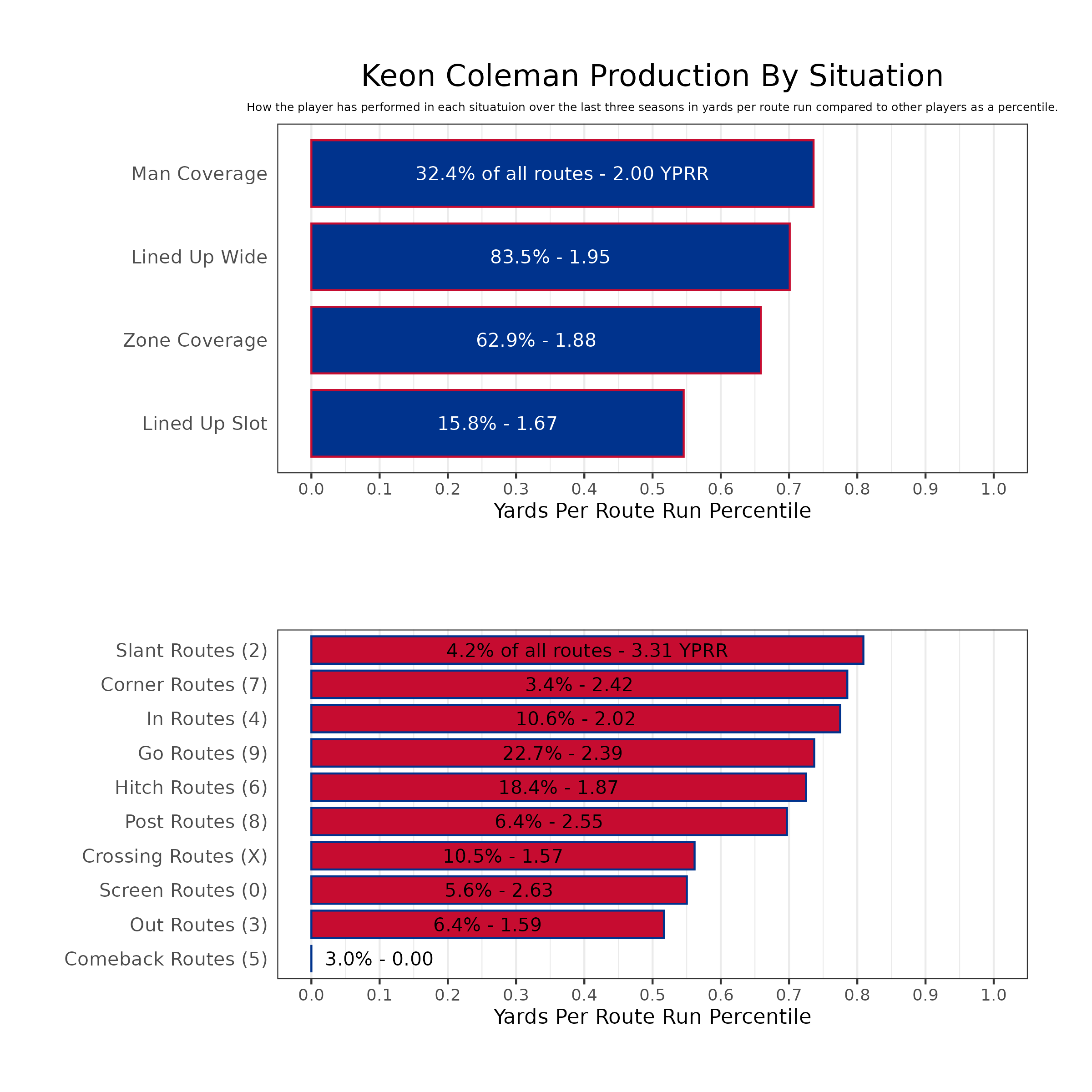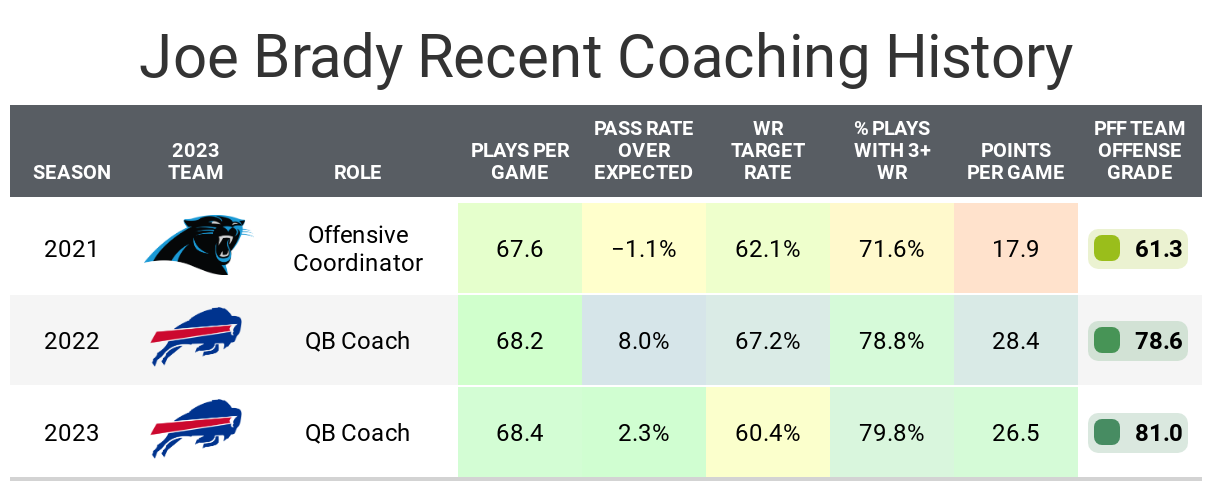• Keon Coleman has a clear path to playing time: He should be the Buffalo Bills’ primary X receiver as long as he can beat out Mack Hollins and Marquez Valdes-Scantling.
• Coleman could have the Gabe Davis role, which might not be great: Davis was the tall X receiver for the Bills in recent seasons and had sporadic fantasy production.
• Dominate fantasy football season with promo code PFF25: Unlock all of PFF's fantasy content and tools, including full access to the fantasy football mock draft simulator, for 25% off using promo code PFF25.
Estimated Reading Time: 5 minutes
The fantasy football player profile series gives the most in-depth view of a player using the best data points at PFF’s disposal. We will look at how well the player has performed, the player's competition for touches and how teammates and coaches will impact the player's performance.
Last updated: 7:15 a.m. Tuesday, Aug. 6
Player Performance
The Bills made Coleman the 33rd pick in the 2024 NFL Draft. The 6-foot-3 receiver was called a “top-tier athlete for the position from an explosiveness standpoint” in PFF's 2024 draft guide. He lacks agility and isn’t the best at separating, but he displayed excellent contested-catch ability in college.
Coleman didn’t necessarily stand out statistically in college. He was a starter the past two seasons with above-average numbers, but you would expect someone drafted as highly as Coleman to excel in more areas. He was drafted early more so because of what he could become as a receiver.
Bills quarterback Josh Allen has said Coleman is “what we needed in our offense.” Since the start of training camp, there has been nothing but praise for Coleman, both for his play on the field and for his interactions with a fan off the field.


Competition for Touches
The Bills have gone through a complete makeover of their wide receiver room. Stefon Diggs, Gabe Davis, Trent Sherfield and Deonte Harty — four of the team's top five wide receivers in 2023 — are all off the roster.
Khalil Shakir is the primary player returning. Along with Coleman, Buffalo brought in Curtis Samuel, Khalil Shakir, Marquez Valdes-Scantling, Mack Hollins and Chase Claypool. Shakir and Samuel are more likely to play Z receiver and in the slot in three-receiver sets. While Coleman will compete with both for targets, he probably won’t be competing with them for playing time.
Coleman’s competition is Hollins and Valdes-Scantling. Hollins and Valdes-Scantling have high average depths of targets and low target shares because they aren’t great at separation. They add value to the offense because they can help clear out safeties, but they aren’t going to have much fantasy value.
Most of Coleman’s playing time will likely be determined by how quickly he can develop. There’s a path to him playing more than 90% of offensive snaps if he masters the playbook and gains Josh Allen’s trust. If that takes some time, it wouldn’t be at all surprising to see him rotating with at least one of those two wide receivers early in the season.
This is taking Davis’ role in the offense, and Davis didn’t have that high of a target share. The offensive philosophy may change with Coleman, but it’s also possible Coleman will have a low target share yet flash with some big plays.


Impact of Teammates
Josh Allen is one of the biggest reasons to be excited about Coleman. Allen has a decent deep-target rate but not the best deep-ball accuracy, but it’s possible Coleman will thrive even if the passes aren’t perfect. Along with Allen comes a high-scoring offense, and given Coleman’s height, he should be a monster in the endzone. He will need a high touchdown total to be a fantasy starter.
Bills offensive coordinator Joe Brady took over the role in Week 11 last season. Gabe Davis’ production in the offense was sporadic before Brady was offensive coordinator, and it got worse after Brady took over. In six games under Brady without getting injured, he had two outings with 100-plus yards and a touchdown, one game with 21 yards and three games without a catch. If Coleman really does take Davis’ role in the offense, it would be a nightmare for fantasy managers.


Bottom Line
Coleman is a very risky fantasy prospect with huge rewards. If everything goes right, he is Josh Allen’s favorite target. In the past, Allen’s favorite target was a consistent top-10 fantasy wide receiver. A lot needs to go right for that to happen, with the most likely scenario being that he has some excellent weeks and other quiet ones. His ADP is WR46, so anyone drafting him isn’t necessarily relying on him to be in fantasy starting lineups immediately.
Footnotes
- Statistics for the tables and charts were generally chosen based on their ability to predict future fantasy performance on either a per-game or per-opportunity basis, or chosen for their ability to describe the player relative to other players at the same position.
- Opportunities for this purpose are defined by passing dropbacks, rushing attempts and receiving routes run.
- Numbers are either by season or based on the past three years. For rookies, only college numbers are included. For non-rookies, only NFL numbers are included, even if they played in college in the past three years.
- Because college competition is relatively easier than NFL competition, most rookies will see a decline in their NFL numbers compared to their historical numbers.
- For all of the tables in this article, colors range from blue (good or high) to red (bad or low).
- All percentiles or colors are comparing the given player to other players with a large sample of opportunities. Generally, it’s one-third of the possible opportunities given the sample. If the player in question doesn’t have enough opportunities, they are still compared, even though a player could look very good or bad on that small sample size, which might not be as predictive.
- Information on running back utilization classifications and importance can be found here, wide receiver here and tight end here.




 © 2024 PFF - all rights reserved.
© 2024 PFF - all rights reserved.